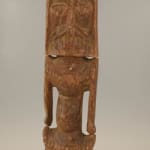Lobi Wooden Anthropomorphic Spoon, 20th Century CE
Wood
4 x 18.25
PF.5820 (LSO)
Further images
This intriguing object is a spoon – probably of ceremonial purpose – made by the Lobi tribal group. It is anthropomorphic, with short, thick legs, an elongated trunk and nugatory...
This intriguing object is a spoon – probably of ceremonial purpose – made by the Lobi tribal group. It is anthropomorphic, with short, thick legs, an elongated trunk and nugatory arms, supporting a tall, rectangular head. The figure is essentially unadorned, except for small eminences (perhaps designating clothing?) on the hips and further limited detailing on the chest. The face is carved in low relief, with oval eyes in depressed surrounds, a T-bar nose and a laterally-slanting mouth. The apex of the head – approximately 1/3 of its total height – is marked with vertical-diagonal relief lines denoting an ornate coiffure. The back of the figure is essentially plain, with the back of the head hollowed out as a rectilinear receptacle that would have allowed the piece to be used as a scoop-like implement. Condition is good, with an encrusted patina.
The Lobi were founded sometime in the 18th century, when they moved to their current territory of Ghana, Togo and Burkina Faso. The term “Lobi” – whose name literally means “children [lou] of the forest [bi]” in Lobiri – covers various subclans (including the Lobi, Birifor, Dagara, Dorossy, Dyan, Gan and Teguessy) which can be differentiated, but which are usually identified as a homogenous unit by academics as they share common traits in terms of architecture and village structure, social/religious beliefs and thus artistic production. The country is intimately tied up in their beliefs. For example, the main river along which they settled – the Mounhoun – is believed to symbolise the division between this world and there hereafter, and must be crossed upon death; for this reason many Lobi initiation rites take place on its banks, and the animals which frequent it and its surrounds are considered sacred. They are an exceptionally martial group, and have a long history of struggles and sanguineous battles with long-serving enemies including the Guiriko and Kenedougou empires. The French, unsurprisingly, had problems with colonial administration in the area, and embarked upon a bloodbath of oppression in order to bring them under control. This powerful resistance also extended to Christianity, which the Lobi have eschewed for decades. Christian missionaries working in southern Burkina Faso reported that an elderly man in a Lobi village renounced the spirits in favour of Christianity by discarding his fetishes in a nearby lake. As he turned his back on the traditions, the fetishes leapt out of the lake onto his back again to reclaim him. Possibly for this reason, the artefacts associated with traditional belief systems are comparatively common, and display a healthy range of diversity that is often absent in older pieces from areas where the formidable power of forced Christianity was successfully brought to bear upon the native populations.
Lobi artistic production is intimately tied up with their beliefs. While much of their artistic repertoire is associated with devotional items – figures known as “bateba” which serve either an apotropaic function (Bateba Duntundora) or act as personifications of thila spirits whose personal qualities are especially desirable – they are also known for their decoration of utilitarian and secular objects. Prominent examples include vessels, catapults and – in the current case – utensils. This is a well-rendered and well-preserved piece of African art.
The Lobi were founded sometime in the 18th century, when they moved to their current territory of Ghana, Togo and Burkina Faso. The term “Lobi” – whose name literally means “children [lou] of the forest [bi]” in Lobiri – covers various subclans (including the Lobi, Birifor, Dagara, Dorossy, Dyan, Gan and Teguessy) which can be differentiated, but which are usually identified as a homogenous unit by academics as they share common traits in terms of architecture and village structure, social/religious beliefs and thus artistic production. The country is intimately tied up in their beliefs. For example, the main river along which they settled – the Mounhoun – is believed to symbolise the division between this world and there hereafter, and must be crossed upon death; for this reason many Lobi initiation rites take place on its banks, and the animals which frequent it and its surrounds are considered sacred. They are an exceptionally martial group, and have a long history of struggles and sanguineous battles with long-serving enemies including the Guiriko and Kenedougou empires. The French, unsurprisingly, had problems with colonial administration in the area, and embarked upon a bloodbath of oppression in order to bring them under control. This powerful resistance also extended to Christianity, which the Lobi have eschewed for decades. Christian missionaries working in southern Burkina Faso reported that an elderly man in a Lobi village renounced the spirits in favour of Christianity by discarding his fetishes in a nearby lake. As he turned his back on the traditions, the fetishes leapt out of the lake onto his back again to reclaim him. Possibly for this reason, the artefacts associated with traditional belief systems are comparatively common, and display a healthy range of diversity that is often absent in older pieces from areas where the formidable power of forced Christianity was successfully brought to bear upon the native populations.
Lobi artistic production is intimately tied up with their beliefs. While much of their artistic repertoire is associated with devotional items – figures known as “bateba” which serve either an apotropaic function (Bateba Duntundora) or act as personifications of thila spirits whose personal qualities are especially desirable – they are also known for their decoration of utilitarian and secular objects. Prominent examples include vessels, catapults and – in the current case – utensils. This is a well-rendered and well-preserved piece of African art.







